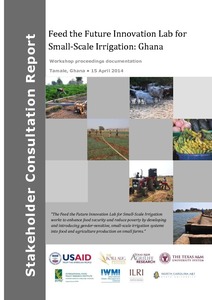Rapid assessment of nutrition and food safety risks in dairy value chains in Tanzania
Integrated termite management for improved rainwater management: A synthesis of selected African experiences
In eastern Africa, termites are perceived by farmers, livestock keepers, and many development agencies as serious agricultural pests that destroy pasture, crops and wooden infrastructure. Commonly use control measures have proven to be ineffective.
Enhanced community resilience to drought through innovative market based systems approaches: Improving pastoral livelihoods in Kenya
A conceptual flash flood early warning system for Africa, based on terrestrial microwave links and flash flood guidance
A conceptual flash flood early warning system for developing countries is described. The system uses rainfall intensity data from terrestrial microwave communication links and the geostationary Meteosat Second Generation satellite, i.e., two systems that are already in place and operational.
Feed the future innovation lab for small-scale irrigation, Ghana: Workshop proceedings and documentation, Tamale, Ghana, 15 April 2014
Inter-connection between land use/land cover change and herders’/farmers’ livestock feed resource management strategies: A case study from three Ethiopian eco-environments
We assessed land use/land cover changes from remotely sensed satellite imagery and compared this with community perceptions on availability/use of livestock feed resources and feed deficit management strategies since the 1973s in three districts representing the pastoral, agro-pastoral and mixed crop-livestock eco-environments of Ethiopia.
Climate change adaptation in mixed crop?livestock systems in developing countries
Mixed crop?livestock systems produce most of the world’s milk and ruminant meat, and are
particularly important for the livelihoods and food security of poor people in developing
countries. These systems will bear the brunt of helping to satisfy the burgeoning demand
for food from increasing populations, particularly in sub?Saharan Africa and South Asia,
Climate change impacts on animal health and vector borne diseases
Assessing drought displacement risk for Kenyan, Ethiopian and Somali pastoralists
A new way of thinking This study reflects emerging awareness of the need to see disasters as primarily social, rather than natural, phenomena. Individuals and societies can act and take decisions to reduce the likelihood of a disasters occurring or, at the very least, to reduce their impacts and the levels of loss and damage associated with them.
Indigenous Peoples and the Extractive Sector
This report provides an overview of the present state of play of the extractive industries in relation to indigenous peoples, taking as its point of departure the adoption of the UN Declaration on the Rights of Indigenous Peoples(UNDRIP) in 2007, together with the 2009 UN Permanent Forum on Indigenous Issues International (UNPFII) Expert Group Meeting on Extractive Industries, Indigenous People
LAPSSET The history and politics of an eastern African megaproject
‘This study is in-depth, up-to-date and the first of its kind on a massive infrastructure development project in the region, examining its history, politics, evolution, the emergence of actors and interests and effects on the poor and marginalized. It presents the ambitions and ambiguities of a megaproject never seen in the development history of the region.












